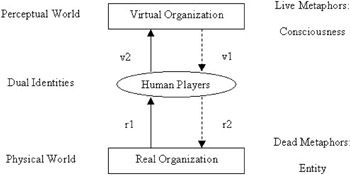Theoretical Findings
Schultze and Orlikowski (2001) examine rhetorical oppositions between real organizations and virtual organizations, and in doing so apply metaphors to the discourse. The visions or views of two opposing elements are not divergent or dichotomous; rather, they offer substitutes for the opposition through a process referred to as dualism. As Orlikowski (1991) proposed in her earlier paper, "The Duality of Technology," this dualism is not mutually exclusive. The dualism originated from the admirable work by Giddens (1984) The Constitution of Society. Giddens's (1984) structuration theory integrated two main streams of sociology objectivism, and subjectivism. It appears that the structuration theory adopts the notion of phenomenology, as it seeks to make explicit the implicit structure and meaning in human experiences (Sanders, 1982). Phenomenology searches for the essence of what an experience essentially is and is the intentional analysis between objective appearance and subjective apprehension. Structuration theory (the process of structuration of an organization), seeks a complementary essence in the structure of organization science and in the process of struggles between objectivism and subjectivism. Interestingly, the conflict of objectivism and subjectivism was reflected in metaphors, as Lakoff and Johnson (1980, p. 189) stated:
Human players have very important roles in both phenomenology and metaphors due to their valuable experience. The key differentiator between objectivism and subjectivism is always human experience. Another important fact (usually overlooked by researchers) is that the use of metaphors appears in both the physical world and in the perceptual world (Harrington, 1991) because the terminology "organization" itself results from dead metaphors. Tsoukas (1991) describes the process in which metaphors "have become so familiar and so habitual that we have ceased to be aware of their metaphorical nature and use them as literal terms" (p. 568) It implies that the metaphors of virtual organizations are live metaphors (Tsoukas, 1991) "knowing that these words are substitutes for literal utterances" (p. 568) that use dead metaphors (organization per se). Therefore, live metaphors are used to describe virtual organizations in another dimension where we can do things that are not possible in the real world, because the virtual world operates without the constraints of time and space unlike the real world. The process of structuration involves the reciprocal interaction of human players and institutional properties of organizations (Giddens, 1984). As Orlikowski (1991) pointed out, "the theory of structuration recognizes that human actions are enabled and constrained by structures, yet these structures are the result of previous actions" (p. 404). Because we live in both real and virtual worlds, we have both objective and subjective understandings of each world dual identities. Figure 1 shows the relationship between real organizations and virtual organizations in the presence of human interveners. Both real and virtual organizations consist of rule resource sets that are implicated in their institutional articulation, thus these rule resource sets act as structures of the organizations (both virtual and real), where a structure is the medium and the outcome of organizational conduct. The structural properties do not exist outside of the actions of the organizational actors. Therefore, structural properties, related to space and time, are implicated in the production and reproduction of the organizations. In other words, both real and virtual organizations undergo structuration across the different sets of dimensions of time and space based on the perspectives of each human player.
The previous model, which is adopted from the duality of technology of Orlikowski (1991), depicts four processes that operate continuously and simultaneously in the interaction between human players and both real and virtual organizations. These processes include: (i) institutional properties, represented by arrow r1 (objective appearance of the real organization) and arrow v1 (objective appearance of the virtual organization), which are the medium of human players; (ii) structures, represented by arrow r2 (subjective construction of the real organization) and arrow v2 (subjective construction of the real organization), which are the product of human players; (iii) the interaction of human players in both worlds, and the resultant influences on the social contexts of the real organization within which it is built and used (the direction of arrow r1 and v2); and (iv) how the virtual organization is built and used within particular social contexts in a real organization (the direction of arrow v1 and r2). In Figure 1, there are two structurations from human players: one for the real organization (r1, r2) and the other for the virtual organization (v1, v2). The realms of virtual organization and real organization are objective while the consciousness of the human player is subjective. We have both objective and subjective understandings of each world (dual identities) because we live in both real and virtual worlds. The maturity phase of the real organization (with its established tradition) and the fledgling state of the virtual organization (with its newly emerging phenomena) indicate that the objective appearance of the real organization (arrow r1) and subjective construction of the real organization (arrow v2) dominate the structuration process in modern organizations. Many observations show that the knowledge and experiences accumulated in real organizations enforce the formulation of the virtual organization in the abstraction process of efficient and effective goal-oriented activity (Mowshowitz, 1994). It is partly true that the creation of the virtual organization is only for the representation of the real organization in virtual space. A considerable amount of explanation arises from rethinking the basic assumptions of time and space. The real organization, whether tangible or intangible, is bound in time and space, while the virtual organization, an imaginative concept established in computer hardware and software, is free from the constraints of time and space.
| |||||||||||||||||||||||||||||||||
| | |||||||||||||||||||||||||||||||||
EAN: 2147483647
Pages: 188

